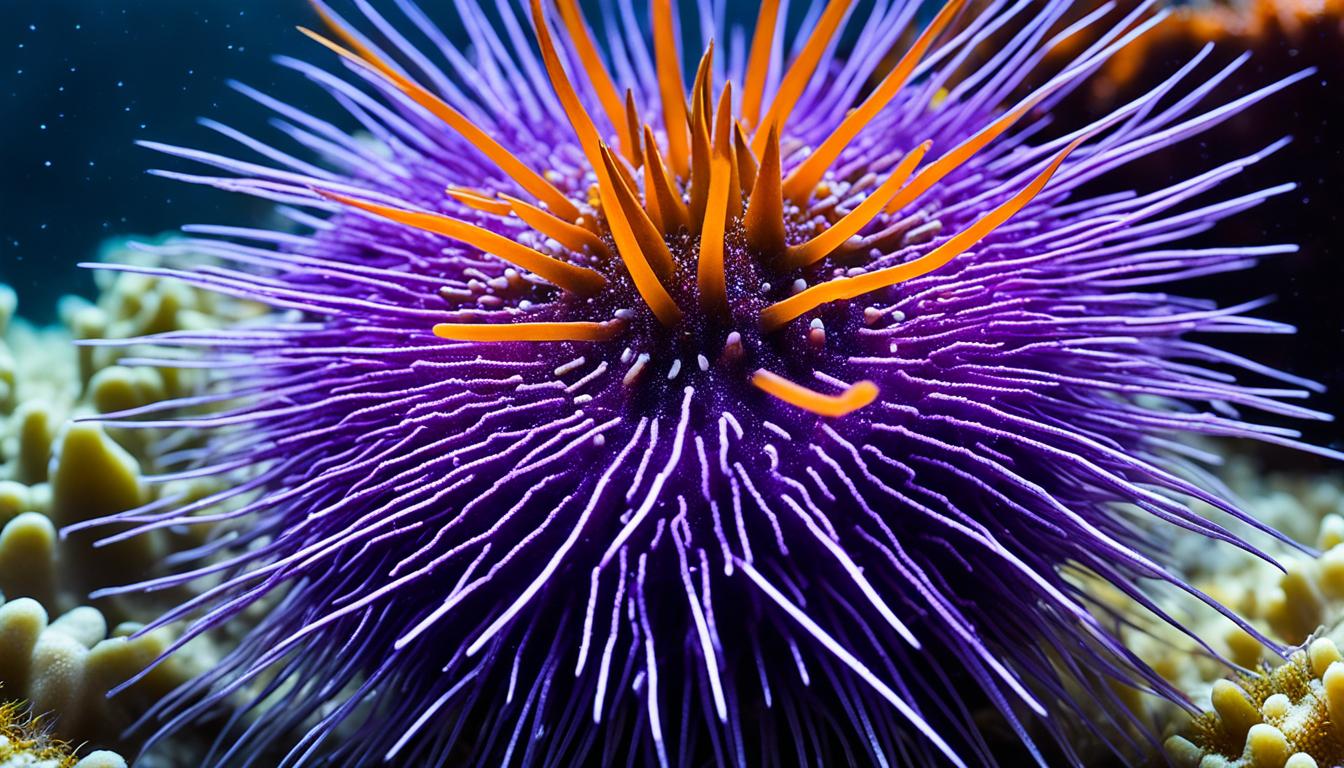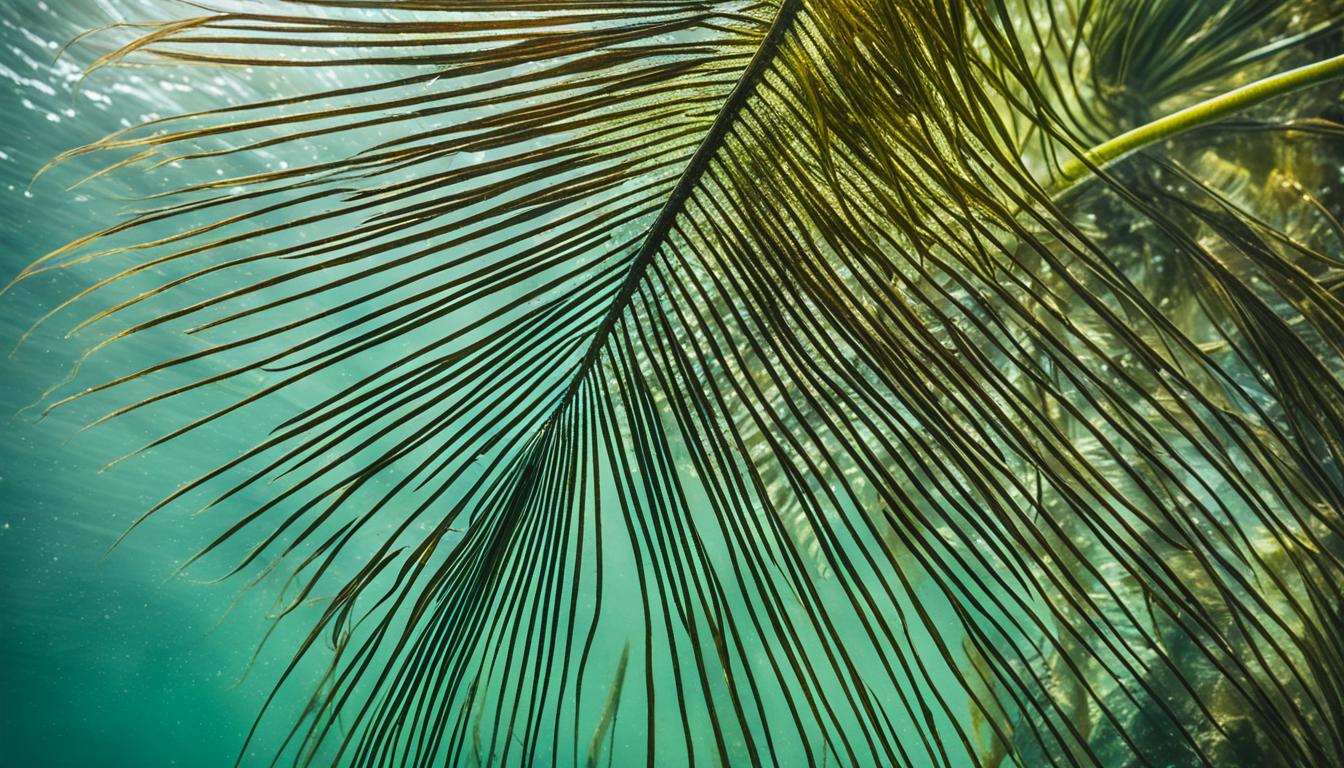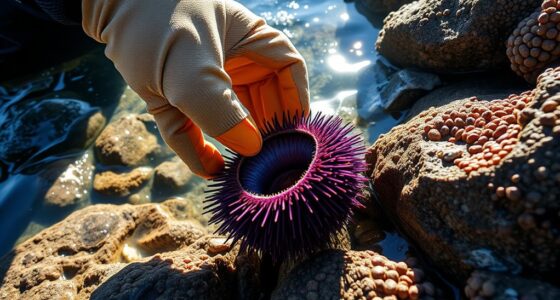Have you ever been amazed by the wonders of the ocean? As someone who loves nature, I find peace in exploring underwater. There, I meet fascinating creatures, like the purple sea urchin. It’s a unique species living off the West Coast of the United States. This urchin, with spikes and mystery, has many secrets to share.
The purple sea urchin is truly captivating. Did you know our oceans are home to over 950 sea urchin species1? Each has amazing features and ways to survive. The purple sea urchin catches the eyes of scientists and food lovers.
Under its spiky shell, there lies a hidden gem called uni. Uni is sea urchin gonads adored in Japanese food for its taste and texture1. But the purple sea urchin brings more to the table. It offers great nutrition too. Full of protein, vitamins, and omega-3 fats, it’s a healthy choice for a tasty meal1.
Key Takeaways:
- Sea urchins, including the purple sea urchin, are a vast group with over 950 species1.
- Purple sea urchins are famous for their uni. It’s loved for its delicious flavor and creamy consistency1.
- Sea urchins are not just tasty. They’re also full of nutrients, like protein, vitamins, and omega-3 fatty acids1.
The Culinary Delight of Sea Urchins
Sea urchins are a special treat, loved in the Mediterranean and East Asia. The part you eat, called uni in Japanese, is actually their gonads. They taste buttery and salty, sometimes sweet2. People like to eat sea urchin raw to enjoy its full flavor. But, it’s also great in many recipes, from sushi to pasta. Adding sea urchin can make any dish feel fancy and special.
Sea urchins are famous for their amazing taste and texture. They have a bright orange color and a smooth feel. The mix of sweet, salty, and umami flavors in uni makes any meal memorable2. That’s why both chefs and food lovers often seek out sea urchins.
Sea urchin roe captures the sea’s flavor in a unique way. Its creamy consistency makes other ingredients taste better. Sea urchin can be added to sushi, pasta, or sauces2. It transforms dishes into extraordinary experiences.
Exploring the World of Sea Urchins
Sea urchins are found in a big family of over 950 species, each adapted to its own place. Among them are the green sea urchin of the Atlantic and the purple sea urchin of the U.S. West Coast. These animals have a tough outer shell and sharp spines for defense. Their reproductive parts are eaten as a fancy food. Sea urchins are interesting both in fine dining and for their role in the ocean3.

Sea urchins live in many ocean spots, like rocky shores and coral reefs. They adjust well to different places, showing their toughness and value to the ocean’s health. Sea urchins even help protect coral reefs by eating 45% of algae. This helps keep the reef’s environment in balance3.
The Intricate Balance
University of Washington’s Friday Harbor Laboratories did a study on sea urchins. They tested how sea urchins deal with less salt in the water. The study looked at how quickly sea urchins fix themselves, move, and stick to things.
The results showed lower salt levels were tough on them, except they could still stick to things in very low salt. This discovery tells us how sea urchins might cope with big changes like climate shifts. Researchers believe we should consider these changes to help sea urchins survive3.
The Health Benefits of Sea Urchins
Sea urchins are a culinary favorite and a great source of vital nutrients. They are filled with protein, vitamins, and omega-3 fatty acids. These nutrients are important for a healthy diet and have many health benefits.
Sea urchin roe, or gonads, are especially nutrient-rich and have strong antioxidant properties. Research has explored these aspects thoroughly4. Scientists have found important proteins, vitamins, and minerals in them. The research also shows they have bioactive compounds that help fight oxidative stress. This means sea urchins are good for your health.
Sea urchins contain astaxanthin, a powerful antioxidant. This compound is beneficial for the brain and helps keep it healthy as we age4. So, adding sea urchins to your diet is very beneficial.
Sea urchins also have anti-inflammatory benefits. They contain compounds like salmachroman and polyoxygenated furanocembranoids4. These help fight inflammation in the body.
Rich in protein and omega-3 fatty acids, sea urchins are excellent for heart health. Omega-3s reduce the risk of heart diseases. Adding sea urchins to your diet is good for your health.
Sea urchins also have antimicrobial properties. Researchers have found peptides in the green sea urchin that fight off microbes4. This is another reason why sea urchins are good to eat.
Eating sea urchins has many benefits. Yet, it’s important to harvest them in a way that doesn’t harm the ocean. This way, we protect marine life and can still enjoy sea urchins.

Here’s a table with the nutritional values of sea urchins. It lists the amounts per 100 grams of the edible parts.
| Nutrient | Sea Urchin Species | Protein (g) | Vitamin A (IU) | Omega-3 Fatty Acids (g) |
|---|---|---|---|---|
| Red Sea Urchin (Mesocentrotus franciscanus) | Average | 16-18 | 870-900 | 1.4-1.6 |
| Range | 14-20 | 785-950 | 1.0-1.8 | |
| Purple Sea Urchin (Strongylocentrotus purpuratus) | Average | 14-16 | 600-700 | 1.2-1.4 |
| Range | 12-18 | 500-800 | 0.8-1.6 |
Source: Various studies on sea urchin nutritional composition4
Conservation and Sustainability of Sea Urchins
There’s a growing demand for sea urchins, making it vital to focus on their conservation and sustainable use. Overfishing is a big problem for sea urchins and can harm ocean life. We need to use responsible diving and follow rules to help protect these unique creatures and their homes.
The General Fisheries Commission for the Mediterranean (GFCM) is working hard to combat overfishing. It has set up guidelines for farming sea urchins, algae, and shellfish5. Their goal is to balance things out by tackling overfishing and controlling sea urchin numbers to protect underwater plants.
In Procida, Italy, the Echinoidea aquaculture facility is doing great work. They’ve managed to produce over 20,000 sea urchin larvae5. This helps lessen the pressure on wild sea urchins and promotes sustainable harvesting.
Raising sea urchins isn’t easy, though. They often don’t survive well in their early life stages5. But, Procida is showing how it can be done well. This could set an example for sea urchin farming across the Mediterranean, mixing new ideas with restoring ecosystems5.
The GFCM is also guiding on how to carefully restock sea urchins5. They stress the importance of watching over species like sea urchins closely. This is to avoid damage to biodiversity and the places where these animals live. Working together with groups in Spain, they’re trying to fix damaged macroalgal forests and seagrass meadows eaten away by sea urchins5.
Moreover, the GFCM has joined forces with the DACC (Diver-Assisted Coral Conservation). They’re building the Mediterranean Restorative Aquaculture Centre5. This center is all about fostering innovative and sustainable farming methods, including for sea urchins. Their partnership underscores their commitment to sustainable methods and protecting marine life balance.
Conservation Efforts and Research
It’s essential to really understand how sea urchins impact the environment and the risks of overfishing. The research on the purple sea urchin has taught us a lot about sustainable fishing6. This helps identify areas where sea urchin fishing is not sustainable and highlights the need for conservation.
Studies have shown big problems like overfishing leading to negative effects on the whole sea environment6. Another study focused on how fishing impacts the purple sea urchin. It talked about the need to limit fishing and control access to certain areas6.
Research has also looked at how important sea urchins are for the health of coral reefs6. Finding out how changes in water acidity affect sea urchins’ survival gives clues about our oceans’ future6.
Looking into the effects of Marine Protected Areas shows us the challenges and questions about their effectiveness. These studies help in making better rules for these protected areas to truly protect sea life and habitats6.
Sustainable Practices for Future Generations
To keep sea urchins safe and our oceans healthy, conservation and sustainability are key. By practicing responsible diving, supporting farming that helps restore the ecosystem, and encouraging teamwork, we can look after sea urchins. This will also keep our oceans vibrant for the generations to come.
| Reference | Summary |
|---|---|
| 5 | Statistical data extracted from link 1. The GFCM’s focus on restorative aquaculture and guidelines for sustainable replenishment, collaboration with various organizations, and the challenges and potential of sea urchin farming. |
| 6 | Statistical data extracted from link 2. Research on the ecological impact of sea urchins, the consequences of overfishing, assessment of spillover from Marine Protected Areas, and the role of sea urchins in coral resilience. |

Preparation Essentials for Sea Urchins
When you’re getting sea urchins ready, being safe is key. They have sharp spines, so wear gloves and handle them gently. 7
To clean a sea urchin, first open its shell and take out what you can’t eat. Carefully crack open the shell to see the orange parts inside. These parts are tasty and what you’re after. If you see any brown ones, it means they’re bad. Take the good parts out gently, then wash them in cold water. 7
There are two ways to enjoy sea urchins: raw or cooked. Eating them raw? Just use a spoon to get the roe out. It’s a special treat on its own or as sushi topping, known for its rich taste. Prefer cooking? Fry the roe in butter until it’s creamy. Then, you can mix it into dishes like pasta for an exciting seafood flavor. 7
Sea urchin adds something special to your food with its unique taste. You can put it in sushi, pasta sauces, or even creamy soups. Some chefs suggest trying it in scrambled eggs for a fancy breakfast. Its umami flavor works with lots of dishes. 7
To wrap up, always be careful when handling sea urchins. Wear gloves and be gentle. Open the shell, get rid of the parts you can’t eat, and rinse off the good bits. You can eat sea urchins raw with a spoon or cook them in butter. They’re great in sushi, pasta, or as a tasty extra in many recipes. Let your imagination run wild and use sea urchin to make your dishes stand out.

| Preparation Essential | Details |
|---|---|
| Safety | Wear gloves and handle sea urchins with care to prevent injury. 7 |
| Cleaning | Open the shell, remove inedible parts, and rinse roe under cold water. 7 |
| Raw or Cooked | Enjoy sea urchin raw or cook the roe by sautéing it in butter. 7 |
| Serving Options | Add sea urchin to sushi, pasta sauces, or as a flavorful garnish. 7 |
Serving and Pairing Sea Urchins
Sea urchins, with their rich, sweet, and briny flavor, provide a special eating experience. They can be enjoyed in many ways, both traditional and creative. Dive into the world of sea urchins for some culinary exploration.
Traditional Pairings
In Japanese cuisine, sea urchin, or uni, is a treasured ingredient often found in sushi and sashimi. Its creamy texture and deep flavor go well with the subtle taste of these dishes. Italian chefs use sea urchin to make pasta sauces richer and more flavorful, adding a unique touch.
Creative Culinary Ideas
Looking for something new? Spread sea urchin on crusty bread for an easy, fancy snack. Or, mix it into eggs for a breakfast that feels like a treat. Eggs with sea urchin become something extraordinary, perfect for starting your day on a luxurious note.
Sea urchin tastes great with a squeeze of lemon juice. Lemon cuts through the richness, making each bite perfectly balanced. Pair it with seaweed to highlight its oceanic flavors. This adds depth and brings out the sea urchin’s natural taste. For an even more adventurous experience, try incorporating sea urchin into your favorite dishes, like a reef gyoza tasting adventure. The delicate, briny flavors of the sea urchin contrast beautifully with crispy textures, offering a unique twist on a classic. Don’t forget a dash of soy sauce or wasabi to elevate the richness even further.
Wine Pairings
Crisp white wines pair well with the sweetness of sea urchins. Sauvignon Blanc or Chardonnay offer acidity and fruitiness that compliment sea urchin’s flavor. A sip of these wines brings out the best in sea urchin dishes, making the meal more enjoyable.
Garnishes
To make your sea urchin dishes standout, add elegant garnishes. Fresh herbs, like chives or dill, bring freshness and color. A drizzle of high-quality olive oil adds smoothness, enhancing the dish’s taste.
The key with sea urchins is to highlight their distinct taste, using ingredients that support their flavor. This approach ensures a delightful dining experience.

Sea Urchin Harvesting and Storage
Diving for sea urchins is an engaging activity. It happens in kelp-rich areas. Divers catch them using their hands or tools, being careful of the sharp spines. They aim to safely harvest these underwater gems8.
Choosing the right sea urchins is crucial. Divers look for ones with lots of roe. The best are both colorful and smell good. These signs mean the sea urchins are fresh and high-quality9.
After gathering the sea urchins, they must be stored right to stay fresh. They’re often kept cold on ice. Or, they can be stored in saltwater. Both methods keep their taste and texture great9.
Freshness is key to enjoying sea urchins. It’s important they’re handled and stored quickly. This keeps their taste and texture perfect. Methods like keeping them cold are essential9.
Diving and catching sea urchins correctly is essential to get these tasty seafood. Picking fresh ones and storing them right is crucial. These steps ensure they remain a delicious treat. Seafood lovers will then enjoy their unique flavors89.

Key Statistical Data on Sea Urchin Harvesting and Storage
| Statistical Data | Reference |
|---|---|
| Purple sea urchins contribute to a 95% loss of kelp forests in the California region. | 8 |
| The overpopulation of purple sea urchins has been harmful to the coastal ecosystem. | 8 |
| Sea Urchin Harvest has been catching and selling sea urchin uni for over 35 years, indicating a long-standing presence in the industry. | 9 |
| The text mentions that there are four species of sea urchins commercially harvested in Australia, showcasing a diverse range of options within the market. | 9 |
| Centrostephanus rodgersii, known as the purple sea urchin, makes up the majority of the commercial catch in Australia. | 9 |
| Heliocidaris tuberculata, the red sea urchin, can be harvested from southern Queensland to the South Coast of New South Wales. | 9 |
| Heliocidaris erythrogramma, the green, white, or purple sea urchin, is located in southern Australia from sub-tropical New South Wales to Shark Bay in Western Australia and Tasmania. | 9 |
| Tripneustes gratilla, known as lamington sea urchins, are no longer commercially harvested from the wild due to low numbers but will be farmed and commercially available in the future. | 9 |
| The text mentions that uni is at its best when sea urchins are in their peak nutrient-rich stage, which can influence the quality and taste of the product. | 9 |
| Sea urchins should be processed within 24 hours of obtaining them live, emphasizing the importance of timely handling in maintaining quality. | 9 |
| Preparation involves scooping out the uni from the shell and cleaning it carefully, highlighting the meticulous process involved in preparing sea urchin for consumption. | 9 |
| Sea Urchin Harvest emphasizes that all their Uni is caught fresh and delivered fresh, highlighting a commitment to quality and freshness in their products. | 9 |
The Culinary Inspirations of Sea Urchin
Sea urchin, known as “uni,” is a unique delicacy. It wins over taste buds with its umami taste. Originating in Japanese cuisine, it has gained worldwide popularity.
Chefs globally have embraced sea urchin, creating new dishes. They’ve added it to everything from toast to eggs, making meals tastier.
People love sea urchin for its mix of sweet and salty flavors. It brings a special touch to meals, delighting food lovers everywhere.
Sea urchin goes from ocean to dining table, loved by both chefs and customers. Its ability to improve any dish has made it famous worldwide.
Exploring Sea Urchin Varieties
Sea urchins vary in size, color, and shape, with about 700 types worldwide10. Notable ones for cooking include the purple, red, and green sea urchins10.
Health Benefits of Sea Urchin
Sea urchin is tasty and healthy. It’s packed with protein, fiber, and minerals like zinc. It also has omega-3 fatty acids, good for the heart10.
They’re low in mercury, making them a safe, nutritious choice. This is according to the Natural Resources Defense Council10.
Global Gastronomic Influence
Sea urchin has gone from Japanese dishes to global menus. Chefs everywhere use it to innovate and delight.
You can find sea urchin dishes in various places. From luxury seafood spots to fusion restaurants and street food, it’s everywhere.
The Future of Sea Urchin Cuisine
Sea urchin’s presence in global cuisine is strong and growing. Chefs and food lovers keep finding new ways to use it. This ensures sea urchin’s lasting popularity.
The Culinary Delight of Sea Urchin in Numbers:
| Statistical Data | Reference |
|---|---|
| Approximately 700 known varieties of sea urchin worldwide | 10 |
| Sea urchin species: purple urchin (Paracentrotus lividus), red sea urchin (Strongylocentrotus franciscanus), green sea urchin (Strongylocentrotus droebachiensis) | 10 |
| Sea urchin is rich in protein, dietary fiber, minerals (like zinc), beta carotene, Vitamin C, and Vitamin A; high in omega-3 fatty acids | 10 |
| Sea urchins have low mercury load and do not bio-accumulate toxins | 10 |

Conclusion
The purple sea urchin is a known gem in the culinary world, famous for its sweet to briny taste. It is also rich in important nutrients like protein, vitamins, and omega-3 fatty acids. But, it’s vital we look after the purple sea urchin populations to keep our oceans healthy11.
Cleaning and handling sea urchins safely is key when preparing them. They can be eaten raw or cooked, giving an exotic twist to dishes like sushi or pasta. Trying different recipes with sea urchins opens up exciting new flavors and memorable meals.
Purple sea urchins are remarkable in adapting to changing environments12. Studying them teaches us a lot about marine ecosystem health and balance. They also help us understand the ocean’s health by their place in the food web and their role as ocean health indicators.
In the end, the purple sea urchin is not just a treat for the taste buds but also beneficial for health. We need to protect these sea creatures to maintain the balance of marine ecosystems. By mastering how to prepare them and exploring different ways to serve them, we get to enjoy the unique taste and cultural value of the purple sea urchin.
FAQ
What is a sea urchin?
What are the culinary uses of sea urchins?
What are the nutritional benefits of sea urchins?
Why is conservation and sustainability important for sea urchins?
How should sea urchins be prepared?
What are some serving and pairing suggestions for sea urchins?
How are sea urchins harvested and stored?
What culinary inspirations can sea urchin provide?
Why are purple sea urchins considered a culinary treasure?
What are the overall benefits and considerations of sea urchins?
Source Links
- https://discover.texasrealfood.com/the-art-of-savoring/how-do-you-eat-sea-urchin – Unveiling Culinary Secrets: How to Eat Sea Urchin
- https://globalseafoods.com/blogs/video/sea-urchin – Fresh Uni: Your Guide to Opening Sea Urchins at Home
- https://artsandsciences.syracuse.edu/news-all/news-2023/sea-urchins-are-struggling-to-get-a-grip-as-climate-change-alters-ecosystems/ – Sea Urchins Are Struggling to ‘Get a Grip’ as Climate Change Alters Ecosystems
- https://ojs.omniakuatika.net/index.php/joa/article/view/1012 – Review: Nutritional Value and Health Benefit of Sea Urchin | Wulandari
- https://www.fao.org/newsroom/story/In-seas-and-stomachs-bolstering-the-long-term-viability-of-sea-urchins/en – In seas and stomachs: bolstering the long-term viability of sea urchins
- https://www.ncbi.nlm.nih.gov/pmc/articles/PMC8908888/ – Sea urchin harvest inside marine protected areas: an opportunity to investigate the effects of exploitation where trophic upgrading is achieved
- https://www.wikihow.com/Eat-Sea-Urchins – How to Eat Sea Urchins: 15 Steps (with Pictures) – wikiHow
- https://www.npr.org/2022/03/19/1087712567/purple-sea-urchin-recipe-uni – Transforming the ‘Roombas of the ocean’ into culinary delights
- https://seaurchinharvest.com.au/blogs/news/all-about-sea-urchins – All About Sea Urchins | Fresh Sea Urchin | Sea Urchin Harvest
- https://foodprint.org/real-food/sea-urchin/ – Sea Urchin
- https://www.latimes.com/food/story/2022-03-03/from-plague-to-delicacy-reconsidering-purple-sea-urchin – From plague to delicacy — reconsidering the purple sea urchin
- https://thesea.org/purple-sea-urchins/ – Purple Sea Urchins










